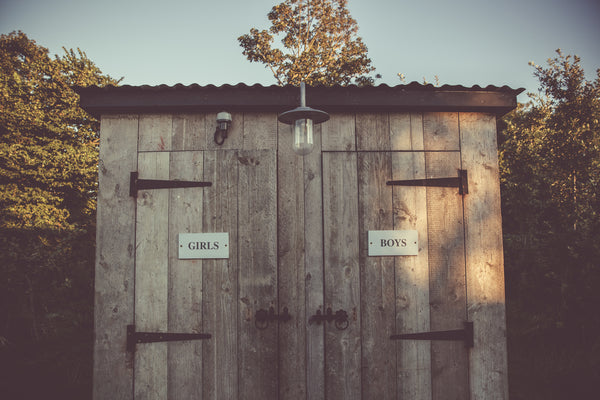Complete History of the Bidet (and Why You Need One!)
Complete History of the Bidet (and Why You Need One!) - Infographic Below

Some things have an obvious invention history.
The lockable cookie jar, for example: it’s the perfect way to keep the cookie monster in your family from decimating the stash before anyone else can get to it. Or a small tracking device meant to attach to your luggage to help you find missing bags - brilliant, right? And obvious.
When it comes to the bidet, though, it’s easy to raise an eyebrow and wonder, “How did that come about?”
The truth is that the history of the bidet is an ancient and fascinating one (even if fascinating isn’t a word you ever thought to apply to a device that washes your bottom for you).
Dating back to the 17th century, the bidet has been an important household item charged with keeping the members of a home clean, fresh, and ready for anything.
Here’s everything you need to know about the history of your new favorite bathroom accessory.
Bathroom Etiquette Through the Ages
Before the bidet, things were pretty rough on the bathroom front. Ancient Greeks are said to have used small pieces of clay or stones (ouch) to wash up after relieving themselves. The Ancient Romans, on the other hand, classed it up a bit by using a piece of sponge on a long stick. The only downside was that the sponge was shared by the entire community. Barf.
Somewhere around the year 1391, a Chinese emperor in the Song Dynasty created a few large sheets of paper, which he ordered installed in his bathroom. This made sense given that, before that moment, Chinese people were just using whatever paper products they could find to clean themselves.
As time marched on, bathroom etiquette did, as well. The rebels left Great Britain in search of the colonies, and they took to using corn cobs to clean their bums. Corn cobs eventually fell out of vogue in favor of paper, which made everyone look at their reading material a bit differently.
Needless to say, the bidet is a significant upgrade to all these methods.
Where’d the Bidet Come From?
As far as historians can tell, the bidet is a French invention. Spearheaded by French furniture makers around the late 17th century, the bidet is a grown-up version of the chamber pot or bourdaloue, which was a small, portable chamber pot classy ladies would take along with them on extended trips.
The word bidet comes from the French word meaning “pony” or “small horse.” This colorful name owes to the bidet’s size and stature, and the fact that traditional bidets look like a small porcelain horse, which you squat over during use.
The first bidets were pretty much just a bowl of water set into a sturdy wooden stool. People would crouch over these primitive bidets and use their hands to wash up. Over the next few decades, the original bidet got more advanced by adopting a hand pump that would spray water. With the advent of plumbing, bidets morphed into convenient devices with nozzles and integrated sprayers.
Today, the bidet is a cleanliness device, widely regarded as more sophisticated and effective than dry wiping. Just a century ago, though, the bidet had many functions, including as a contraceptive device.
The first written reference to the bidet shows up in Italy in 1726. Somewhere around the later half of the 18th century, Maria Carolina of Austria, Queen of Naples and Sicily is said to have requested a bidet for use in her bathroom at the Royal Palace of Caserta.
Lady Carolina was a trendsetter, though, and the bidet didn’t become popular throughout Italy until the end of World War II. Part of the reason for this is that WWII was a bit of a rough time for the bidet. During the foreign war, American soldiers kept seeing bidets in European brothels (re: conception and cleanliness ideas), which gave rise to the incorrect idea that bidets were a tool of immorality, rather than just a nice way to keep your bum clean.
Fortunately, things were about to turn around for the poor little bidet.
The Rise of the Bidet Toilet Seat in the Modern World
Get this: Americans are the only people in the developed world who don’t regularly wash after using the bathroom. (Thanks, Puritan ancestors!)
Since the golden days of the ‘80s, the bidet has been on the rise in the U.S. Although bidets have always been popular in places like Europe, Asia, and the Middle East, Americans are just starting to figure out that (*GASP*) water works better than dry paper when it comes to keeping the nether regions clean.
Here in America, we owe much of the structure of the modern bidet to the Japanese, who took traditional bidets and refined them in the years following World War II. Their handiwork is what eventually became the bidet toilet seat.
While it’s tough to track the exact origin of the integrated bidet toilet seat, most bidet experts believe it was invented in Switzerland. Once there was an original prototype in place, the Japanese bought the patent (the modern-day Toto), and got to work improving it.
While these Japanese masterminds liked the style of the American toilet, they wanted the cleaning functionality of a bidet. Eventually, they decided to combine the two. What they wound up with was a porcelain toilet complete with a toilet seat which offered retractable cleaning jets, controls, dryer, and many other features.
Today, more than 80% of Japanese households have a bidet toilet seat. The popularity of the bidet is spreading across Asia and a dozen companies have sprung up here in the US since the Japanese introduced the bidet toilet seat to the US around 1981, including one backed by Mark Cuban.
While the historical demographic of bidet users in the US tends to be baby boomers discovering the newest luxury they can't live without, but bidets are becoming popular with Millennials as well. Since taking care of yourself and cleanliness has increased in trend, bidets are popping up in urban lofts and fashion forward housing throughout the U.S.; and bidet manufacturers have seen significantly increased demand over the last few years.
But why has bidet use become "all the rage?"
Well, besides bidet toilet seats being easy to install on an existing toilet and all the can't-live-without features like heated toilet seats and night lights, there are very meaningful health and environmental benefits.
The Health Benefits of Using a Bidet
With a history dating back several hundred years, it’s clear that there’s some benefit to bidets. So, what’s the deal? What can a bidet do that plain old toilet paper can’t? Here’s the breakdown:

- Bidets Banish Bacteria. Besides being nicely alliterative, this is a super true statement. By flushing bacteria out and away from the most sensitive areas of your body, bidets work to prevent conditions like bacterial prostatitis, an inflammatory condition that affects the prostates of about 8% of U.S. men. Left-behind bacteria can also cause itching and discomfort, which are some of the most common symptoms that drive people into the offices of colorectal surgeons.
- Bidets Help Prevent UTIs. If you’re a woman who is curious about the history of and current place for bidets, hear this: bidets can help prevent UTIs caused by E. coli bacteria, which is the culprit in about 90% of all UTI cases.
- Bidets Decrease Discomfort. For women with scarring from perineal tears or episiotomies during childbirth, dry wiping can be an uncomfortable experience. Luckily, a bidet can help decrease this. By directing a comforting, warm stream of water at the affected areas, bidets cut down on irritation and friction for a more pleasant ‘go.
What do Bidets do for the Environment?
The answer is simple: some major things.

Sure, bidets are classy, elegant, and cool to make you feel like French royalty, even if the rest of your apartment is on the verge of being condemned, but they’re more than just that. They’re also an incredibly formidable force in the war to end waste and protect resources.
Here’s how they earn all that eco-friendly street ‘cred:
Bidets Reduce Waste
If you’re a living, breathing American, you probably use about 40 rolls of toilet paper each year. That’s about 57 sheets a day. If you install a bidet, though, you’ll be able to slash this number significantly. While you may still want to use a bit of toilet paper to dry yourself off after bidet use, bidets make it easy to flush less of your money (and our global resources) down the toilet.
Bidets also reduce energy consumption and save water. While it takes about 255,000,000 gallons of water to create the 34,00,000 roles of toilet paper the American population uses daily, bidets only consume a tiny amount of water during each cycle.
Bidets Use Minimal Resources
As soon as you mention the bidet power to decrease resource consumption, some critic somewhere will stand up and ask about the environmental impact of bidet accessories like heaters, driers, and massage features.
While it’s true that these things do consume electricity and water, the impact is minimal. If you’re an incredible eco-minded bidet user, you can easily opt for a cheaper bidet seat that doesn’t come with all the bells and whistles.
Bidets Save Trees
Each day, 27,000 trees die to make toilet paper. Additionally, this daily toilet paper hustle requires about 454 tons of chlorine (used for bleaching). Not only is all that chlorine not great for your skin (especially your most sensitive skin), but all those trees could be doing more important work than wiping our bums, like protecting the environment from global warming.
When you install a bidet, you kill fewer trees. You also cut down on the number of harmful chemicals that make it into our water supply and down our drains.
Bidets Protect Your Plumbing
If you’ve ever had to call a plumber to deal with a wad of toilet paper that didn’t quite make it through your toilet’s system, you know the process is expensive, time-consuming, and stressful. Luckily, it doesn't have to be that way.
Bidets cut down on plumbing issues and prevent troublesome clogs in your pipes. This, in turn, saves you money and allows you to enjoy a more functional bathroom, starting at the moment of install.
Are you a wet wipe fan? According to a 2015 New York Times report, the city has spent about $18 million within five years to resolve “wipe-related equipment problems” in the city plumbing. The same thing happens in your home: wet wipes build up in your drains and can create formidable clogs, costly repairs, backed up toilets, and overflowing septic systems.
Get a Bidet: Save the World (and Your Bum)
Unless you’re some kind of masochist who likes the idea of using clay shards to get squeaky clean after going to the bathroom, the bidet is the obvious choice.
Cleaner than dry-wiping, and infinitely more comfortable than a corn cob, bidets have become popular in many developed parts of the world in the years since the Second World War.
Even in developing countries, such as India, where people don’t commonly use bidets, water is regarded as the only way to keep the nether regions clean and avoid troublesome health conditions and unneeded waste.

Or watch this hilarious video:
If you’re interested in seeing how a bidet toilet seat can change your life, check out our list of top-sellers today!

